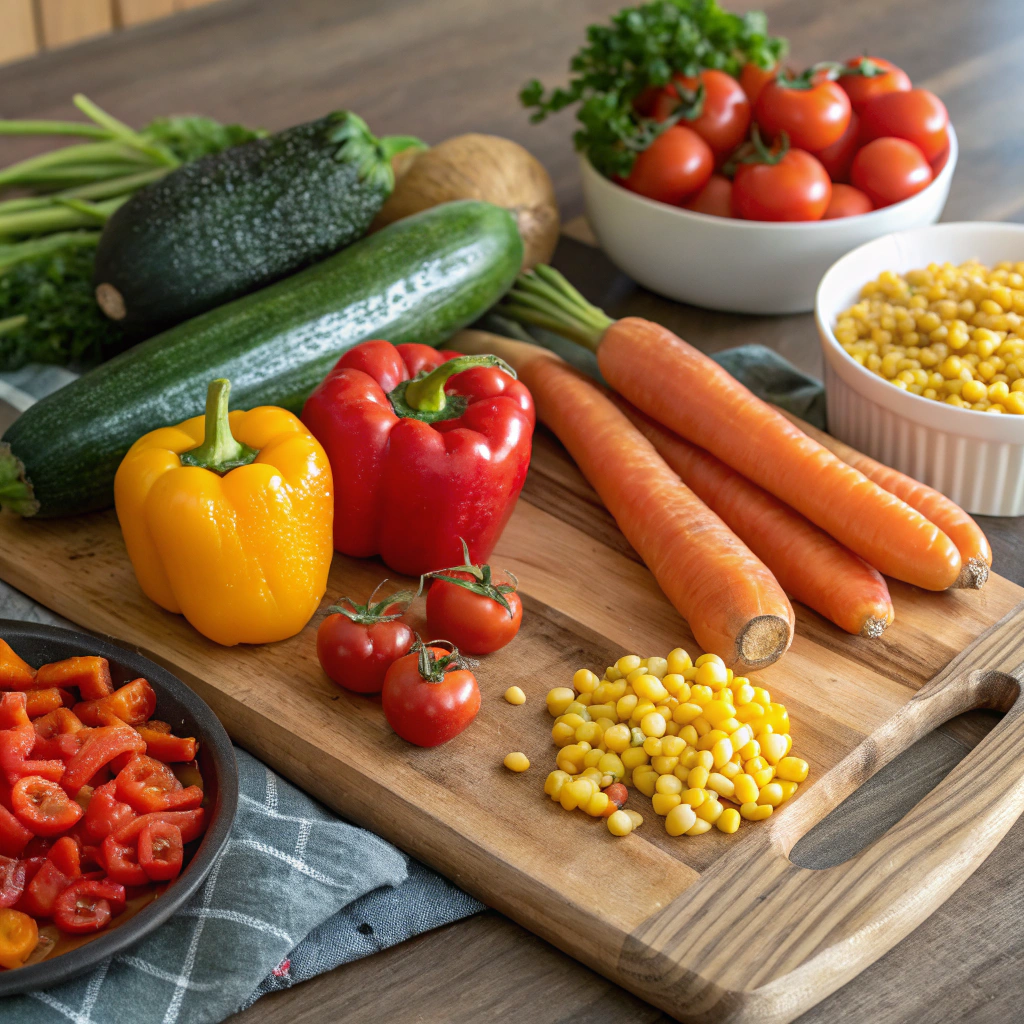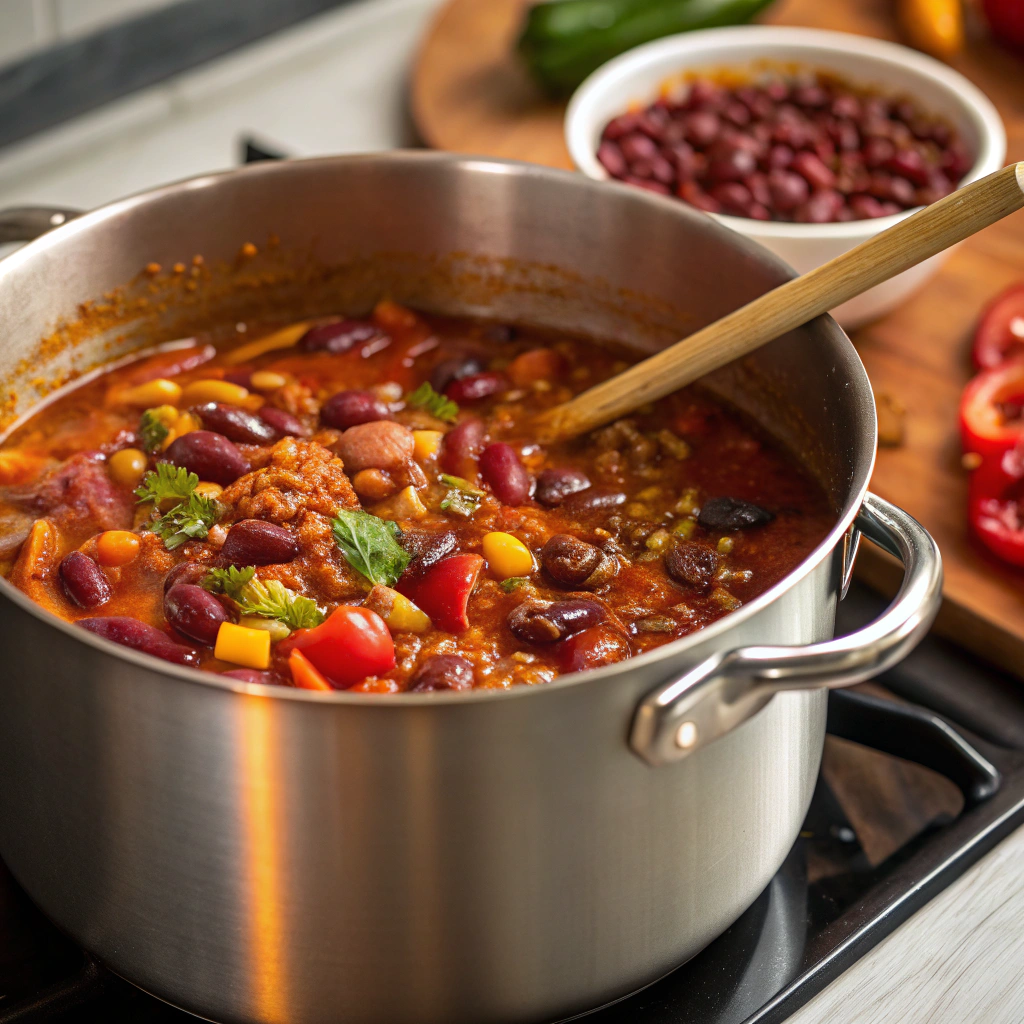Chili Vegetal Recipe has quickly become a favorite comfort food for vegans, vegetarians, and even non-vegans alike. Packed with vibrant vegetables, hearty legumes, and a rich blend of spices, this dish not only satisfies your hunger but also nourishes your body. The beauty of chili vegetal lies in its versatility—whether you prefer a spicy kick, smoky undertones, or a sweeter version, this dish can be adapted to your taste preferences. Let’s dive into why chili vegetal should be your new go-to vegan-friendly comfort food.
The Allure of Chili Vegetal: Comfort Food with a Modern Twist
Chili vegetal is a plant-based version of the classic chili, and it brings a fresh twist to a beloved dish. While traditional chili often features meat, chili vegetal embraces the bountiful variety of vegetables and legumes, creating a hearty meal that’s both flavorful and nutritious. What makes it so appealing is the versatility it offers. You can customize the dish with various vegetables, beans, and spices, allowing you to craft your own signature version.
The growing popularity of plant-based eating further boosts the appeal of chili vegetal. Whether for health reasons, environmental concerns, or ethical choices, many people are opting for plant-based meals. The nutritional profile of chili vegetal is stellar—it is rich in fiber, antioxidants, vitamins, and minerals that are essential for overall well-being. The dish also provides plant-based proteins from beans and legumes, making it an excellent choice for anyone looking to increase their intake of meatless meals.
Chili Vegetal Recipe supports a healthy lifestyle and can help reduce the risk of chronic diseases such as heart disease and diabetes. According to the Centers for Disease Control and Prevention (CDC), eating a variety of fruits and vegetables can help prevent many chronic conditions, and chili vegetal delivers these nutrients in a delicious, easy-to-make dish.

Selecting the Best Ingredients for Flavorful Chili Vegetal
To make Chili Vegetal Recipe , the selection of ingredients is key to achieving depth of flavor and balanced nutrition. A mix of colorful vegetables adds both visual appeal and a wide range of nutrients. Here are some of the best ingredients to use in chili vegetal:
- Bell Peppers: Red, yellow, or green bell peppers provide a sweet and crisp flavor, and are high in vitamin C.
- Onions: Yellow or red onions are essential for adding sweetness and depth to the dish.
- Carrots: Rich in vitamin A and antioxidants, carrots offer both color and sweetness.
- Zucchini: This vegetable adds a mild flavor and texture, and is packed with vitamins and minerals.
- Sweet Corn: Adds a natural sweetness and extra fiber to balance the savory flavors.
- Fresh Tomatoes: Tomatoes provide acidity, richness, and a depth of flavor that enhances the overall dish.
- Garlic and Celery: These aromatics give your chili vegetal a savory, fragrant base.
Don’t forget the legumes—beans are the heart of chili vegetal. Black beans, kidney beans, and pinto beans are all excellent choices, offering a plant-based protein boost. You can use canned beans for convenience or cook dried beans for a more robust flavor and texture.
For the spices, the right balance is essential to achieve the signature warmth and complexity of chili. Must-have spices include:
- Chili Powder: Provides the heat and depth.
- Smoked Paprika: Adds a smoky undertone.
- Cumin and Coriander: Contribute to the earthy, aromatic qualities of the dish.
- Cayenne Pepper or Chipotle Powder: For a spicier, smoky flavor.
Finally, fresh herbs like cilantro or parsley and a squeeze of lime juice will brighten up the dish, adding a refreshing contrast to the rich, savory base.
Essential Tips for Cooking and Customizing Chili Vegetal
Cooking chili vegetal doesn’t require expert skills, but there are a few tips and techniques that can make your dish even more flavorful. Here’s how to elevate your chili vegetal game:
Sauté Vegetables for Depth
Start by sautéing onions, garlic, and peppers in olive oil. This process caramelizes the natural sugars in the vegetables, creating a rich flavor base that enhances the entire dish. Don’t rush this step—let the vegetables soften and develop color to build flavor.
Layer the Spices
Once your vegetables have softened, it’s time to add the spices. Adding chili powder, paprika, cumin, and coriander while the vegetables are sautéing helps “bloom” the spices, releasing their essential oils and intensifying their aroma. Be sure to stir constantly to prevent burning.
Choose Your Cooking Method
You can cook chili vegetal on the stovetop, in a slow cooker, or even in a pressure cooker. The stovetop method allows you the most control over timing, while the slow cooker offers a hands-off approach. Whatever method you choose, make sure to simmer the chili for at least 30-40 minutes to let the flavors meld together.
Adjust Texture and Consistency
Chili Vegetal Recipe can be made as thick or as soupy as you like. To thicken it up, simmer uncovered or mash some beans against the side of the pot. For a soupier consistency, simply add vegetable broth or extra tomatoes.
Customize to Fit Dietary Needs
Chili vegetal is highly adaptable to various dietary preferences. If you’re following a gluten-free diet, ensure that your vegetable broth and canned goods are certified gluten-free. For an extra protein boost, add lentils or crumbled tempeh. Craving a meatier texture? Mushrooms or vegan meat substitutes can create a similar effect.

Chili Vegetal Recipe: Ingredients and Step-by-Step Preparation
Now, let’s get into a straightforward, vegan-friendly chili vegetal recipe that serves four. This version highlights the classic ingredients and is perfect for any weeknight dinner.
Ingredients:
- 2 tablespoons olive oil
- 1 large yellow onion, diced
- 2 bell peppers, diced
- 2 medium carrots, sliced
- 2 celery stalks, diced
- 4 cloves garlic, minced
- 1 zucchini, chopped
- 1 cup corn kernels (fresh or frozen)
- 2 cans diced tomatoes (15 oz each)
- 1 can black beans, drained and rinsed
- 1 can kidney beans, drained and rinsed
- 2 tablespoons chili powder
- 1 teaspoon smoked paprika
- 1½ teaspoons ground cumin
- ½ teaspoon ground coriander
- ¼ teaspoon cayenne pepper (optional)
- 2 cups low-sodium vegetable broth
- Salt and pepper to taste
- Juice of 1 lime
- Fresh cilantro or parsley for garnish
Step-by-Step Preparation:
- Sauté Aromatics:
Heat olive oil in a large pot over medium heat. Add onions, bell peppers, carrots, and celery. Sauté for 6-8 minutes until vegetables are softened and onions are translucent. - Add Garlic and Spices:
Stir in garlic, chili powder, smoked paprika, cumin, coriander, and optional cayenne. Stir for 1-2 minutes until fragrant. - Combine Vegetables and Beans:
Add zucchini, corn, diced tomatoes (with juices), black beans, and kidney beans. Mix well to combine. - Simmer with Broth:
Pour in vegetable broth, bring to a boil, then reduce to low heat. Simmer uncovered for 30-40 minutes, stirring occasionally. - Finish and Serve:
Taste and adjust seasoning. Stir in lime juice, then serve hot with cilantro or parsley as garnish.
Health and Sustainability Benefits of Chili Vegetal
Chili vegetal offers numerous health benefits due to its plant-based ingredients. Here’s how this dish supports your health:
Nutritional Advantages
Each serving of chili vegetal is packed with fiber, vitamins, and minerals. The beans provide protein, while the vegetables add essential vitamins and antioxidants. It’s a great way to increase your fiber intake, which is crucial for digestive health.
Heart and Metabolic Health
By eliminating red meat and saturated fats, chili vegetal is heart-healthy. It can help manage cholesterol levels, support healthy blood pressure, and reduce the risk of heart disease. The American Heart Association encourages incorporating more plant-based meals into your diet for optimal heart health.
Environmental Benefits
Plant-based meals, like chili vegetal, have a much lower environmental impact than meat-based dishes. By choosing chili vegetal, you’re not only taking care of your health but also contributing to sustainability by reducing your carbon footprint.
Serving Suggestions and Creative Variations
Chili vegetal pairs wonderfully with a variety of sides and toppings. Here are some creative ideas to serve and enjoy:
Classic Serving Ideas:
- Over steamed brown rice or quinoa
- With a slice of toasted whole-grain bread or vegan cornbread
- Topped with diced avocado, non-dairy sour cream, or fresh herbs
Creative Variations:
- Chili Loaded Nachos: Top tortilla chips with chili, bake, and garnish with fresh cilantro.
- Stuffed Peppers: Fill halved bell peppers with chili and bake until tender.
- Chili-Stuffed Sweet Potatoes: Serve chili in baked sweet potatoes, topped with green onions.
Storage Tips:
- Store chili vegetal in the fridge for up to 4 days.
- Freeze for up to 3 months, thawing and reheating when needed.
Looking for more easy and satisfying meal ideas? Check out these 8 easy girl dinner ideas, perfect for indulging in some self-care while enjoying delicious, stress-free meals!
Conclusion: Embrace Chili Vegetal as Your Go-To Vegan Comfort Food
Chili vegetal is more than just a plant-based alternative—it’s a nourishing, hearty, and versatile dish that can be adapted to your tastes and dietary needs. With vibrant vegetables, protein-rich legumes, and bold spices, chili vegetal offers a satisfying meal that’s both healthy and sustainable. Whether you’re cooking for yourself or hosting a dinner party, chili vegetal is a dish that’s sure to impress.

1 thought on “How to Make Chili Vegetal: A Flavorful. Vegan-Friendly Comfort Food”
Comments are closed.